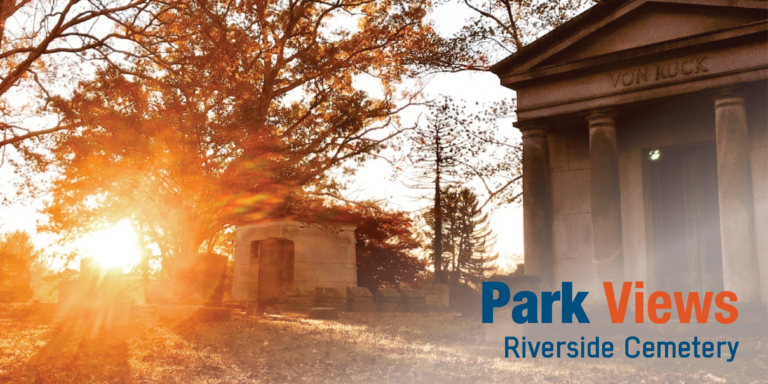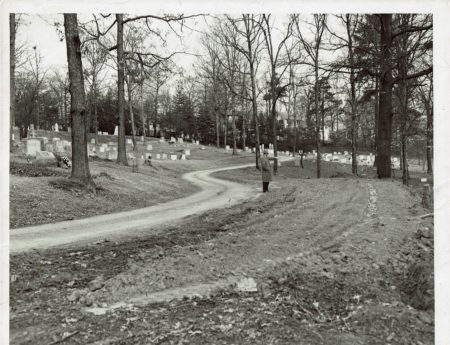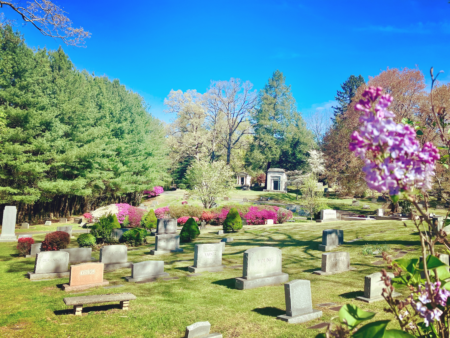This entry is part of Park Views, as Asheville Parks & Recreation series that explores the history of the city’s public parks and community centers – and the mountain spirit that helped make them the unique spaces they are today. Read more from the series and follow APR on Facebook and Instagram for additional photos, upcoming events, and opportunities.
This entry comes from Joshua Darty, manager of Riverside Cemetery. His passion for the cemetery and the stories of its notable occupants led him to create and lead tours of the cemetery and organize restoration projects both within Riverside and other cemeteries in western North Carolina. Available at most booksellers and Buncombe County Public Libraries, his book Asheville’s Riverside Cemetery is filled with an expansive array of historic photos and anecdotes.
“It must be visited to be known; and then we are sure it will soon be learned that what Mt. Auburn is to Boston, Greenwood to New York, Hollywood to Richmond, Bonaventure to Savannah, Riverside will become to Asheville.” – Asheville Citizen, 1886
The Need for a “Modern Cemetery”
As with so much of Asheville’s post-Civil War history, it all began with the introduction of the railroad in 1880. The resulting influx of commerce and tourism caused Asheville to quadruple in size, becoming one of the largest municipalities in the state of North Carolina over the next decade. With a booming population overwhelming its infrastructure and a strong push to become the leading health destination in the southern United States, Asheville’s leaders and businessmen turned their attention to a burgeoning problem – how to properly take care of their deceased.
The existing graveyards in downtown Asheville in 1885 were owned by the Methodist, Presbyterian, and Episcopalian churches and were located along Church Street. These burial grounds were relatively small, collectively just over an acre in size, and were hopelessly overcrowded. To make matters worse, all three churches were in desperate need of the space in order to expand to accommodate their ever-growing congregations.
At the same time, clean water and air, moderate temperatures, and abundant natural resources and beauty of the area were establishing Asheville’s reputation as a place of healthy rest and recuperation. The city completed Beaucatcher Mountain reservoir in 1884 and there were fears that the conditions of existing burial grounds would lead to leaching and contamination of the groundwater system, inviting disease and harming Asheville’s fame.
To alleviate these issues, a group of prominent businessmen and civic leaders began meeting in the early months of 1885 to discuss creating a large, modern civic cemetery that would create sustainable burial practices for the next century and become a draw for townsfolk and tourists in the same way that Mount Auburn had become to Boston or Bonaventure to Savannah. During these meetings, the idea of the Asheville Cemetery Company (ACCo) was born.
The Asheville Cemetery Company
On June 19, 1885, J. Evans Brown and J.P. Sawyer presented the idea of creating what was to become Riverside Cemetery to the Asheville City Council for the first time. After several months, special committees, and promises of financial backing from many of Asheville’s wealthiest citizens, permission was granted by both Asheville City Council and Buncombe County Commissioners. Thus, on August 4, 1885, a claim of incorporation was filed by the company and all of the plans made in preceding months were put into motion.
The first order of business was to secure promised funding through selling stock to individual investors and local government. Three thousand dollars were raised and the search for a suitable location began. Several areas were considered including an expansion of the Newton Academy Cemetery before the new company purchased a 35-acre property at the northwestern part of the city overlooking the French Broad River for the sum of $2,576.25.
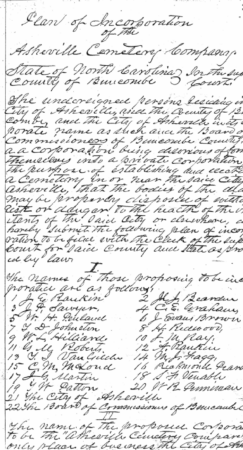 Property purchased, the company had the monumental task of converting the steep hillside into usable lots. They turned to noted English architect C. T. Colyer, an acquaintance of Sawyer who developed an impressive reputation in the United States as one of the foremost landscape architects in European style grounds. Colyer laid out the cemetery grounds in a series of five terraces with three miles of winding white gravel carriageways that hugged the contours of the hill.
Property purchased, the company had the monumental task of converting the steep hillside into usable lots. They turned to noted English architect C. T. Colyer, an acquaintance of Sawyer who developed an impressive reputation in the United States as one of the foremost landscape architects in European style grounds. Colyer laid out the cemetery grounds in a series of five terraces with three miles of winding white gravel carriageways that hugged the contours of the hill.
Colyer designed the cemetery grounds so that visitors walking through would be met with new, unexpected views as they went around blind curves of the roads. Rare trees, flowers, and shrubs were planted to go along with stately oaks which already dominated the landscape.
The burial ground quickly became known as Riverside at the suggestion of real estate agent A.J. Lyman who in 1886 opined in the Asheville Citizen, “Riverside should be the title of the sacred spot, appropriate from the music of the word, from the presence of the flowing waters, and because the stream itself sending up the voice with murmur softened by the distance to mingle with the wailings of the mourner or with the gentle high of the subdued sorrow, seems to ask its share in the expression of emotions.”
A further 42 acres of land in the surrounding area were soon purchased and added to the cemetery – 30 from the Patton and Whitson families and 12 by Congregation Beth Ha Tephila (used to establish Beth Ha Tephila Cemetery, located within the confines of Riverside).
As the grounds neared completion, the ACCo hired two crews – an interment crew and maintenance crew. These were both headed by new superintendent W.S. Cornell, a 50 year-old cheesemaker from Poughkeepsie, New York. Cornell was a business partner of Thomas Walton Patton, now the ACCo’s secretary, and came highly recommended for his business acumen and dedication to his work.
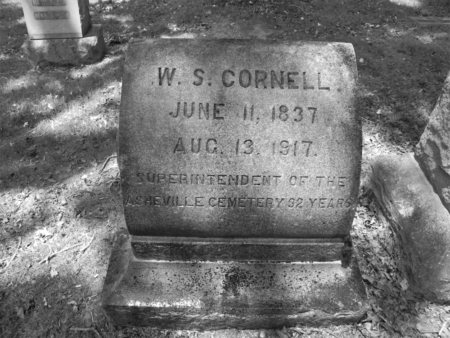 Cornell immediately became the face of the new cemetery. His long white beard and penchant for greeting incoming funeral processions with renditions of hymns became well known in the region. Cornell laid off the first gravesites in Riverside in sections following the alphabet, A-Z. Riverside was very unusual for that time period in the fact that it allowed for both the burial of all races, though the sections were mostly segregated.
Cornell immediately became the face of the new cemetery. His long white beard and penchant for greeting incoming funeral processions with renditions of hymns became well known in the region. Cornell laid off the first gravesites in Riverside in sections following the alphabet, A-Z. Riverside was very unusual for that time period in the fact that it allowed for both the burial of all races, though the sections were mostly segregated.
The first burial in Riverside occurred on December 12, 1885, a few months before schedule due to the sudden death of 25 year old Charles Hill, the younger brother of prominent Asheville businessman J.J. Hill. Cornell became the cemetery’s longest tenured employee, working up until two weeks before his death in 1917 at age 80. His obituary in the Asheville Citizen at the time of his death read, “it was his ambition to keep the city of the dead beautiful, clean and sacred – a home of the departed; and in that work he never wearied.”
Famous Gravesites
Most cemeteries are best known for the famous and infamous gravesites of those buried within – and Riverside is no exception. Literary giants Thomas Wolfe and O. Henry (W.S. Porter), North Carolina governors Vance and Craig, congressmen, artists, craftsmen, a Medal of Honor recipient in the Union Army, and even a personal bodyguard to President Abraham Lincoln continue to draw visitors to the cemetery yearly to pay their respects.
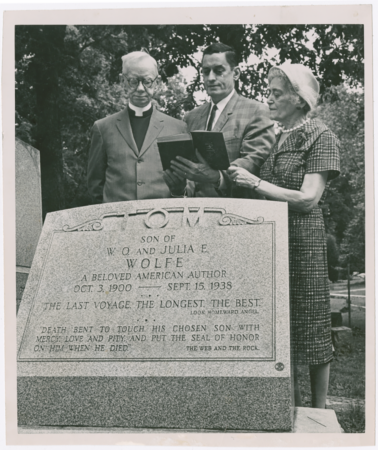 Almost every other street, pathway, park, or public building in Asheville can trace its namesake back to someone interred in Riverside. Undoubtedly, the most visited site in Riverside is the grave of Thomas Wolfe, whose ties to Riverside itself are the strongest. Wolfe, the son of a monument mason, spent many hours in Riverside with his father while the author worked and wrote about the cemetery in his novels Look Homeward Angel and You Can’t Go Home Again.
Almost every other street, pathway, park, or public building in Asheville can trace its namesake back to someone interred in Riverside. Undoubtedly, the most visited site in Riverside is the grave of Thomas Wolfe, whose ties to Riverside itself are the strongest. Wolfe, the son of a monument mason, spent many hours in Riverside with his father while the author worked and wrote about the cemetery in his novels Look Homeward Angel and You Can’t Go Home Again.
O. Henry, though he spent little time in the area, said that these mountains were the only place that he felt at peace and thus was buried by his wife in Riverside far away from his tumultuous life in New York City. His grave is often covered in pennies ($1.87) as a tribute to the first line of his short story The Gift of the Magi.
Zebulon Vance, Confederate governor of North Carolina, has two gravesites in Riverside: one with his first wife Henriette and another with his second, Florence Steele Martin. After his death, his body was moved from site to site as his children and wife argued both privately and publicly about where his final resting place should be. His body was eventually returned to his first gravesite and has remained since.
Lillian Exum Clement Stafford was the first female attorney in the state of North Carolina to own a practice with no male partners. At just 26 years of age, she then did the unimaginable, winning a landslide election to the North Carolina General Assembly before the passage of the 19th Amendment. She was one of the most effective legislators in the assembly, introducing 17 bills and having the vast majority of them in a very short time. She passed away from pneumonia at just 38 years old. Her gravesite is a popular pilgrimage for many on election days, where “I Voted” stickers often adorn her monument.
The gravesite of well-known nurse and midwife Tempie Avery, who lived to be over 100 years old, overlooks her former home site in Stumptown which is now a community center. Avery was born a slave in Morganton in 1817 and came to Asheville enslaved to the Woodfin family. After becoming a free woman, she built her house on Pearson Avenue and continued her practice becoming the most sought after nurse in the area. In 2017, 200 years after her birth, Asheville Parks & Recreation (APR) renamed the center in her honor – Tempie Avery Montford Community Center.
The City of Asheville Steps In
By the late 1940s, the cemetery, though still the preeminent burial ground in western North Carolina and a major tourist draw, found itself in dire financial straits. Revenues declined as many families were unable to pay perpetual care fees and the ACCo found itself operating at a loss. The officers of the company appealed to the City of Asheville in October of 1952 to assume operations of the cemetery in order to prevent it falling into disrepair or closing.
After intense debate from funeral directors, community members, clergy, and rival cemetery owners, City Manager Weldon Weir was able to convince City Council that it was in the best interest of the city to take over the cemetery. On October 24, 1952, the ACCo deeded the 87-acre property to the City of Asheville along with all remaining assets for ten dollars.
Now under new ownership, Riverside was put into the hands of manager Charles “Chick” Hunter, a former funeral product salesman and close friend of Weldon Weir. Hunter had his work cut out for him, as the past decade of underfunding had caused the cemetery to become (in Hunter’s own words to the American Cemetery Association) “unkempt, with a bumper crop of honeysuckle, and an encroachment of weeds and poison ivy in every lot.”
With the help of the City’s Engineering, Streets, and Parks & Recreation departments, things were soon put into order. Lots were cleared, new sections created, water lines ran throughout, and the cemetery office designed by Anthony Lord was outfitted with modern conveniences such as electricity.
Hunter set up a newer, more reliable system for keeping records and used his industry knowledge to help modernize interment methods and create a revenue model that was not reliant on perpetual care payments – instead charging a higher initial cost for a gravesite that could be invested by the City in order to generate interest to pay for upkeep. The City of Asheville’s early commitment to the cemetery coupled with Hunter’s forward thinking management saved the cemetery from certain collapse and have preserved the unique legacy of Riverside for future generations.
Riverside Today
Today, Riverside Cemetery continues to fulfill the promise of its founders to be a modern cemetery for all. Riverside staff have been pioneers in the industry through the use of ground penetrating radar, GIS mapping, digitization of records, and sustainable monument preservation practices. The cemetery is still a very active burial ground, averaging over 75 burials and 25,000 visitors annually. Self-guided tours are available using information from the kiosk at the cemetery’s front gate, from the cemetery office, and online.
Over the past 138 years, Riverside has served as the site of over 14,000 burials and more than 10,000 monuments dot its terraced hillside. Though Riverside Cemetery has evolved with the times, stepping through its wrought iron gates still feels like a step into the past with monuments and trees and pervasive quietness.
Wolfe perhaps says it best in You Can’t Go Home Again: “Some things will never change. Some things will always be the same. Lean down your ear upon the earth and listen.”
Do you have photos or stories to share about Riverside Cemetery? Please send them to cbubenik@ashevillenc.gov so APR can be inspired by the past as we plan our future.
Photo and Image Credits
- Von Ruck Mausoleum by Joshua Darty.
- Asheville Cemetery Company Lot Certificate Header from 1886. Courtesy of Riverside Cemetery Archives.
- Asheville Cemetery Company Articles of Incorporation. Courtesy of Riverside Cemetery Archives.
- W.S. Cornell gravesite by Joshua Darty.
- Graveside service at Thomas Wolfe gravesite.Courtesy of the Thomas Wolfe Collection.
- Chick Hunter surveying Section Z. Photo by E.M. Ball. Courtesy of Riverside Cemetery Archives.
- Section P and Section W3 in spring by Joshua Darty.
